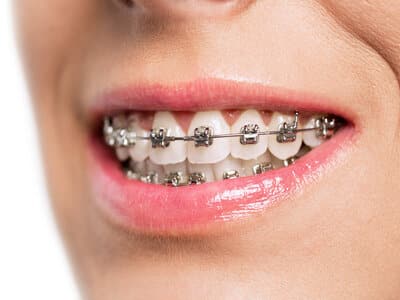
In this post, we will explore:
- Understanding White Spot Lesions (WSLs) with Braces
- Professional Teeth Whitening Options
- At-Home Whitening Solutions
Understanding White Spot Lesions (WSLs) with Braces
White spot lesions, also known as WSLs, can appear on teeth as a result of orthodontic treatment. However, it’s important to note that these spots are entirely avoidable. The presence of WSLs after braces treatment is primarily determined by your brushing habits and oral hygiene routine
To prevent WSLs, it is crucial to maintain clean teeth and follow a robust oral health regimen. Brush your teeth at least twice a day, floss regularly, and make use of fluoride products. An electric toothbrush can be particularly beneficial in reaching areas that are obstructed by braces.
Professional Teeth Whitening Options
While braces-related white spots may not be a concern for everyone, tooth discoloration remains a common issue. Various factors can contribute to this, such as consuming certain foods and beverages that stain teeth, and inadequate brushing and flossing practices.
Thankfully, there are several solutions to address tooth discoloration. Teeth whitening kits are readily available online, over the counter, and from your dentist. Research in the dental field suggests that bleaching or whitening products can effectively improve the color of stained teeth over time. Over-the-counter whitening products generally contain carbamide peroxide, a derivative of hydrogen peroxide, as the active whitening agent. These store-bought whiteners typically contain about 10% of the whitening agent. Prescription options, available through dental professionals, may contain up to 35% of the whitening agent.
Dentists and orthodontists also offer professional cosmetic services for teeth whitening. These treatments employ stronger chemicals compared to over-the-counter options but are safe for your gums and mouth. It’s important to note that professional whitening treatments are temporary and typically last between six to twelve months.
At-Home Whitening Solutions
Beyond professional whitening options, you can also take steps at home to combat tooth stains and discoloration. Your diet plays a significant role in this regard. While certain foods and beverages like coffee, soda, wine, and tomato sauces can contribute to staining, there are also foods that naturally counteract these effects.
For example, incorporating strawberries, apples, celery, and carrots into your diet can help naturally whiten your teeth. These fruits and vegetables contain chemicals such as malic acid in strawberries and saliva production agents in apples and celery, which aid in cleaning your mouth and whitening your teeth.
Foods with high acidity can also increase saliva production but should be consumed in moderation, especially when their acid content is high, to minimize the risk of tooth damage. Additionally, dairy products containing lactic acid may help protect against tooth decay. The proteins in these foods are believed to bind to teeth, providing defense against harmful acids that cause cavities.
Conclusion:
Maintaining a bright, white smile is possible throughout and after your braces treatment. By adopting proper oral hygiene habits, considering professional whitening options, and making smart dietary choices, you can keep your teeth shiny and free